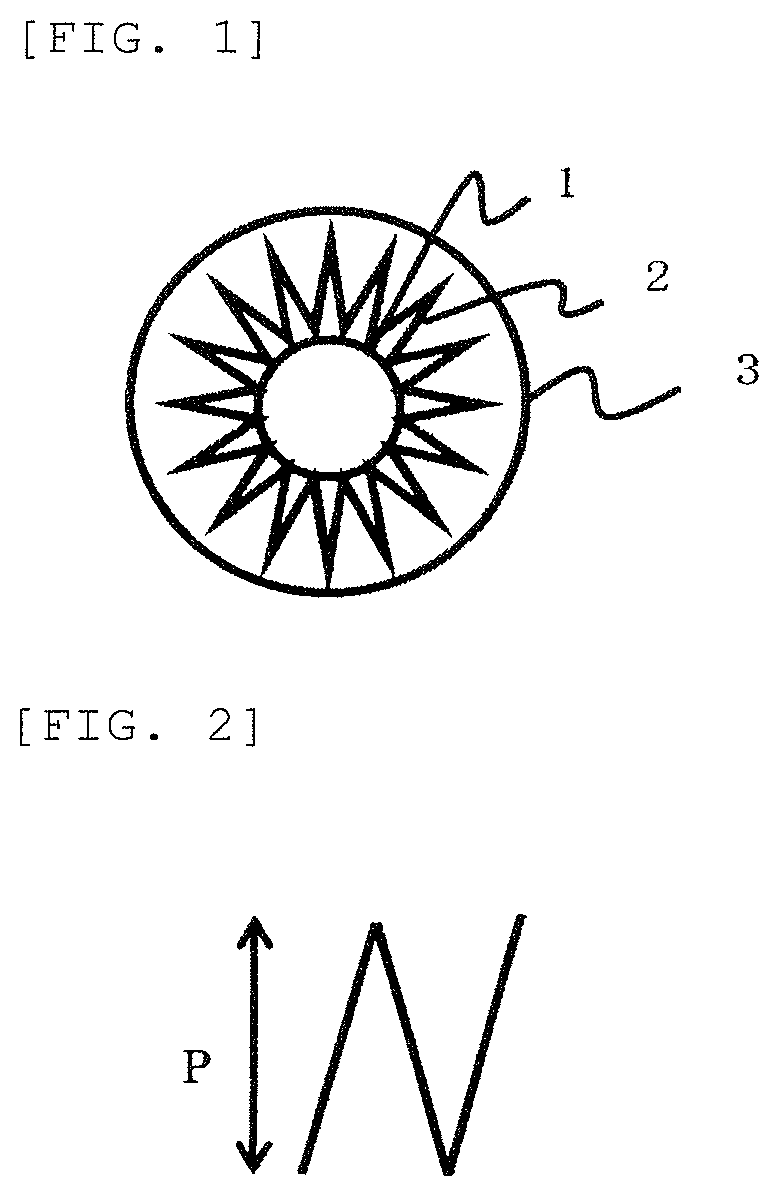Filter medium for liquid filter and liquid filter
a technology of liquid filter and filter medium, which is applied in the direction of filter paper, filtration separation, separation process, etc., can solve the problems of non-uniform pore size of nonwoven fabrics, increased weight per unit, and non-woven fabrics with non-uniform pore size, etc., to achieve high collectability, low weight per unit, and high strength
- Summary
- Abstract
- Description
- Claims
- Application Information
AI Technical Summary
Benefits of technology
Problems solved by technology
Method used
Image
Examples
example 1
[0079]Polyethylene terephthalate (PET) having a melt viscosity of 120 Pa·sec at 285° C. was used as an island component, and modified polyethylene terephthalate obtained by the copolymerization of 4 wt % polyethylene glycol having a melt viscosity of 135 Pa·sec at 285° C. and an average molecular weight of 4,000 and 9 mol % 5-sodium sulfoisophthalic acid was used as a sea component. The polymers were spun at a sea:island weight ratio of 10:90 using a nozzle having 400 islands, and then taken up at a spinning rate of 1,500 m / min. The difference in alkali weight reduction rate was 1,000-fold. The obtained yarn was drawn to 3.9 times the original length and then cut to 0.5 mm using a guillotine cutter to give a sea-island composite fiber. The fiber was subjected to 10% weight reduction in a 4% aqueous NaOH solution at 75° C., and the obtained fiber was used as a main fiber 1 (drawn polyester fiber, fiber diameter: 700 nm, fiber length: 0.5 mm, aspect ratio: 714, round cross-section, bi...
example 2
[0083]Polyethylene terephthalate having a melt viscosity of 120 Pa·sec at 285° C. was used as an island component, and modified polyethylene terephthalate obtained by the copolymerization of 4 wt % polyethylene glycol having a melt viscosity of 135 Pa·sec at 285° C. and an average molecular weight of 4,000 and 9 mol % 5-sodium sulfoisophthalic acid was used as a sea component. The polymers were spun at a sea:island weight ratio of 10:90 using a nozzle having 400 islands, and then taken up at a spinning rate of 1,500 m / min. The difference in alkali weight reduction rate was 1,000-fold. The obtained yarn was drawn to 3.9 times the original length and then cut to 0.4 mm using a guillotine cutter to give a sea-island composite fiber. The fiber was subjected to 10% weight reduction in a 4% aqueous NaOH solution at 75° C., and the obtained fiber was used as a main fiber 2 (drawn polyester fiber, fiber diameter: 400 nm, fiber length: 0.4 mm, aspect ratio: 1,000, round cross-section, birefr...
example 3
[0086]A drawn polyester fiber obtained by spinning and drawing polyethylene terephthalate in the usual manner was prepared and used as a main fiber 3 (single-fiber fineness: 0.1 dtex, fiber diameter: 3.05 μm, fiber length: 3 mm, aspect ratio: 983, round cross-section, birefringence Δn: more than 0.05).
[0087]Next, the main fiber 3 (60 wt %) and the same binder fiber 1 as in Example 1 (40 wt %) were mixed and stirred, and then a filter medium for a filter was produced in the same manner as in Example 1. The evaluation results are shown in Table 1.
PUM
| Property | Measurement | Unit |
|---|---|---|
| diameter | aaaaa | aaaaa |
| diameter | aaaaa | aaaaa |
| thickness | aaaaa | aaaaa |
Abstract
Description
Claims
Application Information
 Login to View More
Login to View More - R&D
- Intellectual Property
- Life Sciences
- Materials
- Tech Scout
- Unparalleled Data Quality
- Higher Quality Content
- 60% Fewer Hallucinations
Browse by: Latest US Patents, China's latest patents, Technical Efficacy Thesaurus, Application Domain, Technology Topic, Popular Technical Reports.
© 2025 PatSnap. All rights reserved.Legal|Privacy policy|Modern Slavery Act Transparency Statement|Sitemap|About US| Contact US: help@patsnap.com

